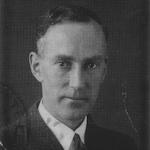
Jan Oort
When Jan Oort visited the Van Vleck Observatory, he had hardly begun making his astronomical discoveries. In fact, he had just received his Bachelor's degree three years earlier and was another two years out of completing his PhD. In April 27, 1924, when he visited the Observatory, Oort was near the end of a two year stint as a research assistant at Yale University. After that year, Oort returned to the Netherlands and spent the rest of his career researching there.
Oort made his largest contributions to the field of astronomy after World War II, when his work with radio astronomy put “the Netherlands at the forefront of postwar astronomy,” according to the New York Times obituary of him. But he started making impressive findings early in his career. In 1927, a year after he received his PhD, Oort became the first person to find direct evidence that the Milky Way Galaxy rotates, confirming a previous hypothesis. In 1932, he discovered dark matter in the galaxy, sparking an important contemporary area of astronomy.
After World War II, he promoted radio astronomy and tried to find out the radio wavelength at which hydrogen is absorbed. It was also in this period that Oort published the thing he is known best for: a proposal on the origin of comets in our solar system. The Oort Cloud, where comets are located, is named after him.
The Facts
OccupationAstronomer
Date & Place of BirthApril 28, 1900 in Franeker, Netherlands
Date & Place of DeathNovember 5 in Leiden, Netherlands
Alma Mater1921 Groningen University (Bachelor's Degree)
1926 University of Leiden (PhD)
April 27, 1924 (age 23 at time of visit)